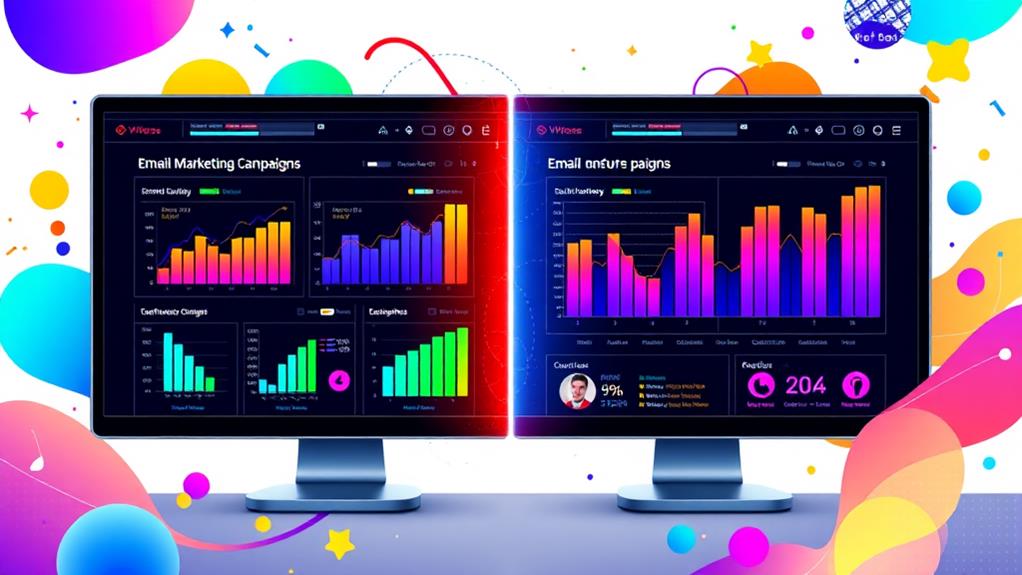Building a high-engagement email list by focusing on quality rather than quantity yields superior results. Engaged subscribers spend 66% more and are 55% more likely to recommend your brand. Prioritizing quality guarantees better deliverability, higher open and click-through rates, and a robust sender reputation. By utilizing dynamic segmentation and personalized content, email campaigns resonate more with the audience, enhancing brand loyalty. Regular engagement monitoring and mobile optimization further boost response rates. This quality-centric approach not only enhances customer relationships but also increases revenue, emphasizing the importance of a carefully curated email list strategy that drives success. Discover more strategies.
Key Takeaways
- Quality email lists enhance engagement, leading to a 66% increase in customer spending compared to less engaged lists.
- Engaged subscribers significantly contribute to brand visibility through word-of-mouth recommendations, boosting brand reputation.
- Personalized content, favored by 80% of consumers, increases open rates by 26% and transaction rates sixfold.
- Mobile optimization is crucial, with over 50% of emails opened on mobile, impacting engagement metrics.
- Regular subscriber management improves deliverability and reduces bounce rates by up to 30%, ensuring effective email marketing.
Understanding Email List Engagement
Email list engagement is a crucial component of successful digital marketing strategies, as it directly correlates with increased customer spending and brand loyalty. Engaged subscribers exhibit a 66% higher likelihood to spend than average customers, underscoring the financial importance of understanding subscriber behavior. This data-driven insight highlights the necessity of focusing on subscriber engagement trends to maximize marketing effectiveness.
One key aspect of engagement is monitoring metrics such as open and click-through rates. High engagement metrics indicate a more interested and active audience, greatly enhancing marketing reach and impact.
Furthermore, 55% of engaged customers show brand loyalty by recommending businesses to others, thereby amplifying the ripple effect of engagement beyond immediate financial gains.
Strategically prioritizing quality over quantity in email lists is essential for maintaining a strong sender reputation. This approach guarantees better inbox placement and deliverability, crucial for maximizing engagement.
Regularly cleaning and optimizing lists to remove unengaged subscribers is imperative. This practice enhances engagement rates, reduces spam complaints, and aligns with evolving subscriber behavior patterns.
Benefits of an Engaged List
Recognizing the importance of subscriber engagement lays the groundwork for understanding the substantial advantages of maintaining a highly engaged email list.
The synergy between subscriber motivations and well-crafted engagement strategies can drive noteworthy business outcomes. Here are four key benefits of an engaged email list:
- Increased Revenue: Engaged customers spend 66% more than average customers, underscoring the financial benefits of focusing on a high-engagement email list. Understanding subscriber motivations allows businesses to tailor offerings, thereby enhancing purchasing behavior.
- Word-of-Mouth Marketing: With 55% of engaged customers recommending businesses to others, an engaged list can appreciably boost word-of-mouth marketing and brand reputation. Strategic engagement efforts guarantee subscribers are enthusiastic advocates for the brand.
- Improved Campaign Performance: Engaged subscribers result in higher open and click-through rates, enhancing overall campaign effectiveness. This improvement is vital for marketers aiming to achieve tangible results from their email strategies.
- Enhanced Loyalty and Retention: Subscriber engagement fosters brand loyalty, with engaged subscribers more likely to remain loyal over time. By aligning engagement strategies with subscriber motivations, businesses can nurture long-term relationships.
These benefits highlight the essential impact of a high-engagement email list on business performance, emphasizing why quality should always trump quantity.
Crafting Compelling Content
In the digital age, the art of crafting compelling content is not just a skill but a necessity for businesses aiming to engage their audience effectively. Evidence suggests that 70% of consumers prefer to learn about companies via articles, emphasizing the crucial role of content storytelling in building an emotional connection. Such connections are essential, as high-quality content can lead to 66% higher spending by engaged customers compared to their less-engaged counterparts.
To achieve this, businesses must focus on creating valuable content that resonates with their audience. This is not only about the text but also about the structure and design. A balanced combination of visuals and text is paramount in maintaining interest and responsiveness. Additionally, regularly producing such content supports brand loyalty, as 55% of engaged customers are likely to recommend businesses to others.
| Key Metric | Impact on Engagement |
|---|---|
| Consumer Preference | 70% prefer articles over advertisements |
| Spending by Engaged Customers | 66% more than average customers |
| Brand Advocacy | 55% of engaged customers recommend others |
Harnessing these insights, businesses can leverage content storytelling to forge stronger emotional connections, ultimately enhancing customer engagement and loyalty.
Personalization Techniques
Incorporating personalization techniques is essential for enhancing email engagement, as evidenced by 80% of consumers favoring tailored content (Epsilon).
By leveraging subscriber data such as demographics and past behaviors, marketers can implement personalized content strategies and dynamic email segmentation to create targeted campaigns that drive higher open and click-through rates.
Additionally, using personalized subject lines can boost open rates by up to 26%, making it important to address subscribers individually and cater to their preferences (Yes Lifecycle Marketing).
Personalized Content Strategies
Many marketers have discovered that personalized content strategies can substantially enhance engagement levels in email marketing campaigns. By employing behavioral targeting and audience segmentation, marketers can leverage valuable demographic insights to craft content personalization strategies that resonate with subscribers.
With 80% of consumers preferring tailored messaging over generic communications, the power of email customization becomes evident. Utilizing detailed engagement analytics allows for an understanding of user preferences, enabling the creation of relevant and compelling content that drives higher open and click-through rates.
- Behavioral Targeting: Analyze subscriber interactions to tailor emails based on past behaviors, enhancing relevance and engagement.
- Audience Segmentation: Use demographic insights to group subscribers, allowing for targeted and personalized communication strategies.
- Content Personalization: Implement dynamic content that adjusts to user preferences, offering a customized experience that increases conversion likelihood.
- Engagement Analytics: Employ A/B testing to measure the effectiveness of different personalized content strategies, optimizing engagement rates and campaign success.
Personalized subject lines alone can boost open rates by 26%, highlighting the significant impact of tailored messaging.
Dynamic Email Segmentation
Harnessing the power of dynamic email segmentation empowers marketers to deliver content that is meticulously tailored to subscriber behaviors, preferences, and demographics. By leveraging dynamic targeting strategies, businesses can greatly enhance relevance and engagement, resulting in emails that generate up to six times higher transaction rates than their non-personalized counterparts.
This approach is not just about dividing lists; it is about understanding and predicting subscriber actions using behavioral triggers to send timely and relevant messages.
Segmentation based on engagement levels




